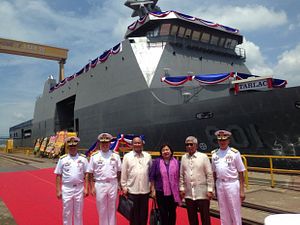Over the weekend, the leaders of Indonesia and the Philippines both took stock of a historic maritime boundary agreement between them as part of a summit meeting. The move spotlighted the landmark 2014 pact between the two Southeast Asian states and ongoing efforts that they are trying to make further inroads on it within their wider bilateral ties.
As I have observed previously, among the most significant developments in contemporary Indonesia-Philippines security ties was the conclusion of a maritime boundary agreement in May 2014 that delimited the overlapping exclusive economic zones (EEZs) between the two countries. The legally-binding pact, which marked the conclusion of negotiations that began around two decades earlier, has since been highlighted as not only a positive development for bilateral ties, but also a potential model for Asian states looking to address such differences in line with international law.
Since then, both sides have been looking to move forward with formalizing and implementing the agreement reached, in spite of lingering challenges therein as well as opportunities in their wider defense relationship. One key step in this was the approval of the agreement by both legislatures. Indonesia’s parliament ratified it back in April 2017, and the Philippine legislature finally did so just earlier this month in another key step forward.
Over the weekend, the deal was the headlines again following a further discussion of it by the two countries. As anticipated, the agreement was discussed on June 22 on the sidelines of the 34th ASEAN Summit in Thailand, which is chairing the regional grouping this year, by Indonesian President Joko “Jokowi” Widodo and Philippine President Rodrigo Duterte.
Per a statement issued following the conversation between the two leaders, both sides said they welcomed the completion of domestic requirements in the two countries for the entry into force of the agreement, which they said was a “valuable example” of peaceful, rules-based settlement of maritime borders in accordance with the 1982 United Nations Convention on the Law of the Sea (UNCLOS), a provider of legal certainty for the two countries, and a promoter of deeper collaboration in their respective maritime sectors.
There was also a reference made to next steps in the agreement as well. Both leaders said they looked forward to the entry into force of the agreement within the end of the year upon the exchange of the instruments of ratification by their foreign ministers. In addition to being a quick follow up step, it would also be a symbolic boost for ties as it would come amid the commemoration of the 70th anniversary of bilateral relations.
Whether or not this will happen as scheduled, and the extent to which we will see progress on the implementation of the agreement, remains to be seen. Nonetheless, the reaffirmation of the pact by the two leaders and the willingness of both sides to move forward on it nonetheless attests to its importance both within the bilateral relationship as well as for the wider region.































